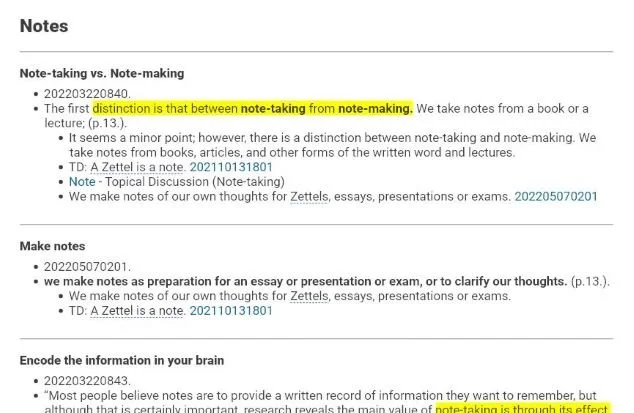Personal Knowledge Management (PKM) using TheBrain software is a blog series devoted to discussing the methodologies used in creating and maintaining a life leadership system. Episode 8 - Mark, enter, scribble or scrawl.
In Episode 7, we chatted briefly about research, and I laid out four quotes that have shaped my research thoughts into what they are today.
Basic Research (I don't know what I am doing)
Use a single source as the starting point for news.
DevonThink (keep entries in smallish chunks)
Leonardo da Vinchi "This is to be a collection without order."
"A Zettel is a Note." [1] I clearly remember the first time I read this line. The term is German, and the whole idea of a Zettelkasten was a foreign subject. Thankfully, I could wrap my brain around an index card file or "slip-box" because I had made a feeble attempt years ago to keep my growing pile of notes in such a box. A slip-box is the English equivalent to zettelkasten; therefore, I had a handle on what was discussed, feeble tho it might be. I'm also old enough to have used a library card file to look up books, so I felt I might be able to handle this note-taking methodology created by Niklas Luhmann.
I won't spend any time detailing the life of Niklas Luhmann in this blog. His life was unique, and so was his methodology. You can read about him on Wikipedia.
Sonke Ahrens made the Zettelkasten world come alive with the book he published in 2017, How to take Smart Notes. I have not read the book. I came close to buying; however, a review said, "save your money and visit the website: Zettelkasten.de." So I lurked on the website, reading blogs and the forum before joining in October 2019. I’m no longer an active participant on the website; however, I learned a lot from my time as a member.
In his book, Mr. Ahrens outlines a seven-step process from "Fleeting Notes" to creating an academic paper. [2] Fleeting notes are simply capturing every idea on the fly. Although I don't use the term "fleeting note" in my vocabulary, we reviewed capturing every thought in Episode 5 - Threads.
Episode 8 is about writing a note. It seems a minor point; however, there is a distinction between note-taking and note-making. We take notes from books, articles, and other forms of the written word and lectures. We make notes of our thoughts for essays, presentations, or exams. [3] In other words, we take notes on what others have said (input) and make notes on what we think and say (output). [4]
These distinctions become helpful when capturing information, ideas, or thoughts in our personal knowledge management system.
In Episode 6, I mentioned taking notes from the chapter in a book. To accomplish this, I capture all the views I find of interest in one long text file separated only by title and UID. Technically these are sequential notes designed to keep the author's original intended chain of ideas; I have simply extracted those individual atoms I found of interest. [5]
“Chapter notes in one long .txt file” copyright BrickBarnBlog2022
The tallest stumbling block in understanding either the zettelkasten methodology or taking notes for a PKM is that in taking notes, I am collecting someone else's ideas. [6] These concepts are not my own; yet. The best essay I have read on the subject is a Q&A by Bob Doto "I just finished reading a book and took lots of notes. Now what?"
After taking notes, the next step becomes somewhat divergent depending on why you read the book, article, essay, or white paper. Mr. Doto recommends taking those ideas that correspond to what you're currently working on. [7] However, what if you're not working on anything? It is possible to take notes with no specific purpose, [8] and perhaps that is the most significant distinction between the zettelkasten and the personal knowledge management system. It is also a very subtle difference that can cause frustration. However, both require connecting thoughts, i.e., Related to... (also discussed in Episode 6), and both will need your thoughts on the subject.
You've captured the input; it's time to make your output. If I have thoughts, I prefer to catch them on the go while scribbling down the original author's idea as fast as I can. [8] A quick indented bullet point can accomplish a lot to distinguish the difference between my thoughts and the thoughts of others. If the picture I have connects to a chain of thoughts now, we're rolling with a potential article, blog, or white paper of my own.
In Episode 9, we will
Written August 6, 2022
Contains portions from the blog article The Zettelkasten Method: A nonlinear zettel note format. October 18, 2021
References:
[1] Fast, Sascha. “Zettelkasten.” *4 Use Cases to Determine What a Zettel Should Be • Zettelkasten Method*, 13 Sept. 2015, zettelkasten.de/posts/what-is-a-zettel/.
[2] “Interesting Review of How to Take Smart Notes.” *Zettelkasten Forum*, 22 Mar. 2020, 8:53 AM, forum.zettelkasten.de/discussion/956/interesting-review-of-how-to-take-smart-notes#latest.
[3] McPherson, Fiona P.hD. (2018). Effective Notetaking, 3rd edition; Wayz Press. p.13.
[4] Braddock, Mike. “Introduction & Teaching Using ZettelKasten and Paskian Entailment Meshes.” Zettelkasten Forum, 16 Feb. 2020, [forum.zettelkasten.de/discussion/comment/4212/#Comment_4212](http://forum.zettelkasten.de/discussion/comment/4212/#Comment_4212).
[5] Gescho (2019, September 4). Retrieved from https://zettelkasten.de/posts/lattice-of-thoughts/
[6] https://writing.bobdoto.computer/question-i-just-finished-reading-a-book-and-took-lots-of-notes-now-what/
[7] ibid
[8] McPherson, Fiona P.hD. (2018). Effective Notetaking, 3rd edition; Wayz Press. p.91.


